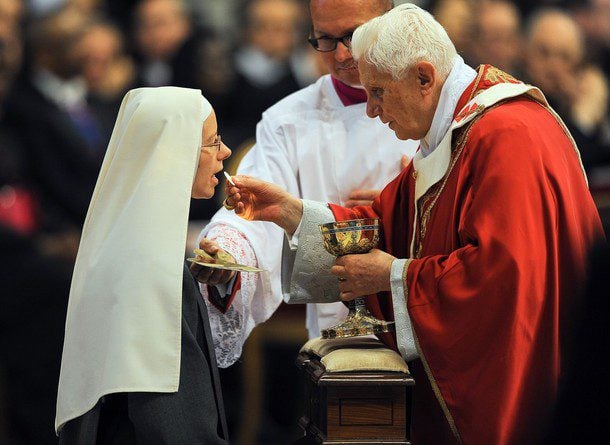If, like I’ve shown, everyone practices liturgy, why then is there a distinction between liturgical denominations and Evangelicals? Why does the latter get grumpy with the former about all their rules, motions and symbols? Now, the common answer goes something like this: “Because, Catholic and Lutheran and all the rest, your ancient liturgy is overly complicated, elitist, snobbish, pretentious, and dripping with wealth. It is all high and detached, boring, old, stuck-in-the-pews, unrelatable to the modern age. The average human being must feel completely isolated amidst it all, as do the youth. It is a party for old, rich, white people, and one can get to God in easier, simpler ways.” Does that sound about right?
Good, because I agree with it completely. I just agree with it in reference to modern evangelical liturgy, not the Mass. Let’s pretend – for an instant – that we aren’t the spoiled, rich, and probably white, Internet-soaked children that we are, and that we actually are your average human being.
| …or this is your main form of Sunday worship… |
| …or this is mildly annoying, then I’m talking to you. |
If your average human being – pagan, post-Christian or what have you – stumbles into a Catholic mass he will – to the most extent – understand the basics. He will understand that it is about Christ, by the crucifix. He will understand it is about worshipping that Christ by all the liturgical kneeling, bowing and genuflecting that goes on. He will understand that the bread and wine are important – by the candles that surround them, the precious metals they are contained in, by the incense and the bells; in short – by the liturgy that surrounds them. But it is a very good chance that he would not be as easily able to understand a prayer-circle, mega-church or non-denominational chapel. If modern evangelical liturgy is indeed simple and relevant, it is only because it is incomprehensible to those not “in the know”. Blanks walls are simply blank walls to those unaware of what goes on within them. An empty cross is empty. And while you might always walk into a church, you must be invited into a prayer-circle.
Though it secretly is, this is not to say one liturgy is better than the other – for truly, some of my most intimate encounters with God have been within circles of fellow Christians. Instead, this is to ask: Can you not see how evangelical liturgy – which falsely claims to be a lack of liturgy – is simply not enough? That the claim that ancient liturgy is elitist, irrelevant, and isolating is just silly? (Good, me too.) The Universal Liturgy, far from making worship elitist, makes worship public; available. Whereas Evangelical and non-denominational liturgy has effectively attempted to make the private, personal worship of the Christian the same as the public, and has thus limited the liturgy to those who have private, personal encounters with God in the first place, a thing that many of us, saints and sinners alike, have difficulty with. As an example, take the public confessing of sins that so many Evangelical churches include in their liturgy. This takes the personal and private confession of sin to God (or for the Catholic, the privacy of the confessional) and puts it in public liturgy. And thus, those most likely to take part in this public confession of sin are those who already practice the private confession of sin, while those who already find it difficult to confess their sins to God are ‘no way in hell’ going to stand up and tell everyone that they fornicate on the weekends.
Again, the problem is not confessing sins to one another. That is a very good and holy and helpful practice. The problem is the attempt to make that action liturgical, to make what is private worship public worship. The exact same thing – the public confession of sin – takes place at a Catholic Mass. Everyone, priest and congregation, says:
I confess to almighty God,
and to you,
my brothers and sisters,
that I have sinned through my own fault,
in my thoughts and in my words,
in what I have done,
and in what I have failed to do;
and I ask blessed Mary,
ever virgin,
all the angels and saints,
and you,
my brothers and sisters,
to pray for me to the Lord our God.
But what an immense difference! Here we see a prayer specifically designed as a public exclamation, as a universal claim, as a united recognition of our common failure. It is public worship pronounced publicly, not private worship rammed into a public affair. So that’s why I’m all about old-school liturgy; it makes worship truly available.
And this is a truth that we Catholics – I don’t know about the rest of you liturgical, but still heretical, denominations – often have trouble admitting to. See, there is a temptation to revel in the depth and sublime beauty of our faith, in it’s intricacies and secrets, and certainly; all these things are available. But the Liturgy is universal to the point of stupidity. (Maybe that’s what this post will be remembered for; Catholic liturgy is stupid.) Regard for instance, this conversation that never happened:
Maker of Liturgy: Alright, so the bread turns into Jesus. Awesome. How are we going to signify that? We need to let people know when it happens.
Intelligent Human: Well, we could have the congregation echo the words of the disciple Thomas, and the priest then –
Catholic: Bells!
Maker of Liturgy: I’m sorry?
Catholic: You know, bells? As in: Ding-a-ling-a-ling-a-ling, heeeere’s JESUUUUS!
Intelligent Human: Don’t You think that’s a little blatantly obvious?
Catholic: BELLS! BELLS! BELLS! BE-
Maker of Liturgy: Alright, alright. Uh, let’s move on, shall we? The priest needs to show his reverence for the altar, and thus for the sacrifice of the Eucharist. What should he do?
Intelligent Human: Well, in this case a cruciform blessing would be appropriate, perhaps with holy water, and then –
Catholic: Naw, just let him kiss it.
Maker of Liturgy: What?
Intelligent Human: Are you completely retarded?
Catholic: Just give it smooch, you know? Like: Hey altar, I like you!
Intelligent Human: Screw this, I’m becoming Amish.
And so on. In every aspect of the liturgy, you can almost guarantee that Catholics are performing the most human of responses to divine truths. The bread is God? Alright, let’s put it in a box made of gold. Mary is beautiful? Alright, let’s draw a picture of her. The ultimate example of this happy stupidity is a Monstrance. A Monstrance contains the Body of Christ and shows it to the people. What does the word ‘monstrance’ mean? Literally. a show-er. Goodness.
So there you have it. Ancient liturgy is the cat’s pajamas because it is not – despite popular complaint – elitist, isolating, snobbish, pretentious or any of the rest. It is catholic in the true sense of the word. And this will all make even more sense in my next post, in which I reveal the third and oft’ forgotten definition of liturgy; the only definition worth following.











